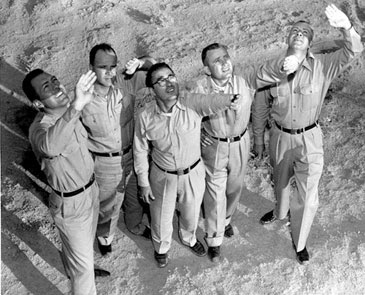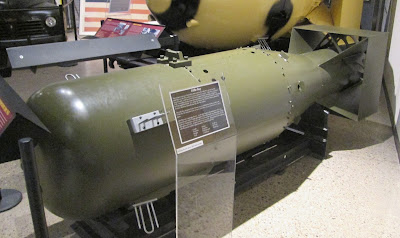Yet from one more field trip. The Nuclear Museum, Albuquerque, New Mexico, USA. I recommend this museum highly, without qualification or reservation. This blog entry concentrates on those images of atomic weapons as developed by the U.S. military to be used in a time of nuclear war.
To the images:
SIGABA. American cryptographic machine from the era of the Second World War [WW2]. Like a German Enigma but possessing three banks of five rotors each. Was used until 1959. Reputedly no message ever encrypted by SIGABA was ever read by an adversary.
Nuclear depth charge on carriage. From the era of the Cuban Missile Crisis.
British atomic bomb from the era of the Cold War.
Genie air-to-air missile on carriage with atomic warhead. Could be fired at a Soviet bomber of group of Soviet bombers over an American city and detonate without danger to the populace below! See the You Tube video of a Genie being fired from a warplane and exploding, an occurrence as it was during the Cold War when above-ground testing was still done. Genie length: 9 feet 8 inches (2.95 meters).
American Air Force officers observing a high-altitude Genie missile nuclear detonation. Sans headgear each man for uniformity, the explosion directly overhead. Perfectly SAFE as you can see!
A B-83 atomic weapon on carriage with Permissive Action Link [PAL] unit attached. That bomb could not be activated for use unless the proper "go-codes" punched into the PAL.
A close-up of the PAL unit.
A cabinet containing a whole assemblage of PAL units. PAL soup to nuts so to speak, from the earliest designs to the most recent.
Recovered Broken Arrows showing damage. "A Broken Arrow is defined as an unexpected event involving nuclear weapons that result in the accidental launching, firing, detonating, theft or loss of the weapon."
Davey Crockett. Smallest American atomic weapon as fielded. To be used against massed formations of Soviet tanks. Dimensions are: 30 inches [76 mm] long and measured 11 inches [28 mm] in diameter (at its widest point).
For some sense of scale here is an American troop next to a Davey Crockett as the weapon would have been set up prior to firing.
The back-pack atomic demolition device. SADM. An atomic weapon broken down into sections, carried by special operations troops and assembled at the target for detonation. Total weight is 163 pounds (74 kilograms).
A Lego blocks model of CP-1. Chicago Pile One. Graphite moderated experimental nuclear reactor. Achieved the first self-sustaining and controllable nuclear reaction.
Yet one more model of CP-1 Note the lab tech in the lower right corner.
Fat Man. Nuclear weapon dropped on Nagasaki. A plutonium as opposed to a uranium bomb.
This is Fat Man on carriage and personnel. It was not without reason the bomb was called Fat Man.
Little Boy. First atomic bomb. Dropped on Hiroshima. A uranium gun-type atomic bomb.
The Gadget. The plutonium implosion bomb. First atomic detonation, experimental only. NOT a use-able weapon.
The Gadget as it appeared in 1945. Before the first atomic test. That appears to NOT be J. Robert Oppenheimer in the lower left corner.
So much more to the Nuclear Museum too. Full name The National Museum of Nuclear Science and History. I have only shown those images as found inside that deal with atomic weaponry.
Outside exhibits include static displays of nuclear weapons delivery systems, bomber aircraft and missiles, thermonuclear devices, etc.
Again, I recommend the museum highly. If you are in the Albuquerque area it is well worth the visit.
coolbert.























No comments:
Post a Comment